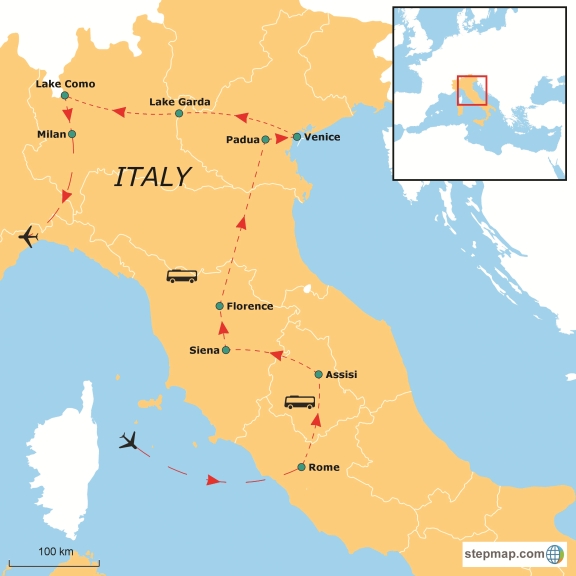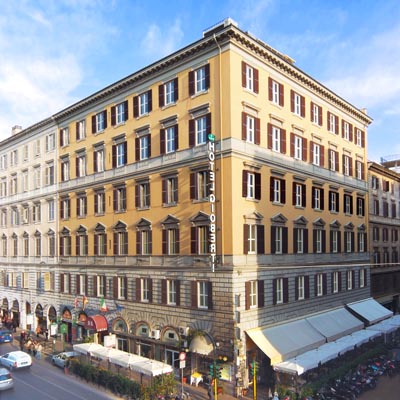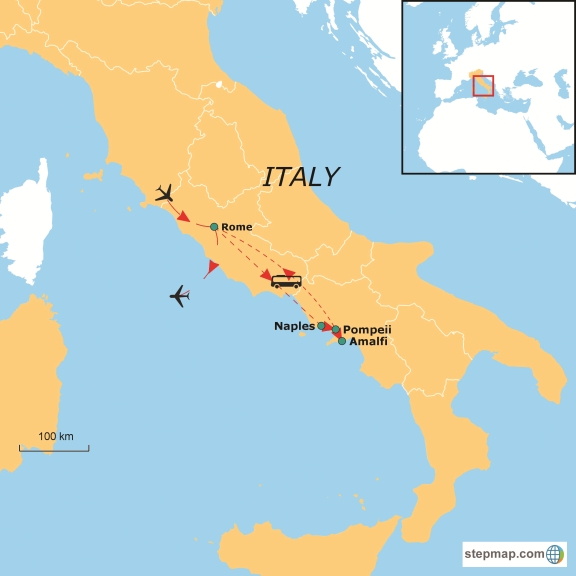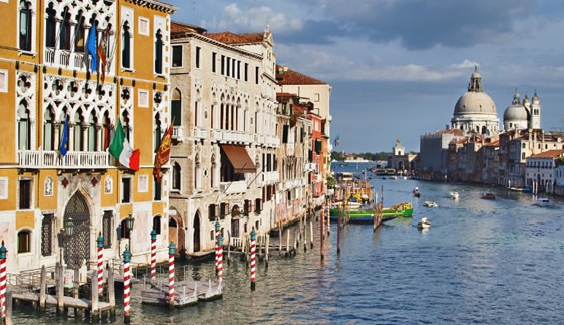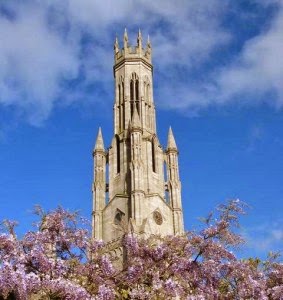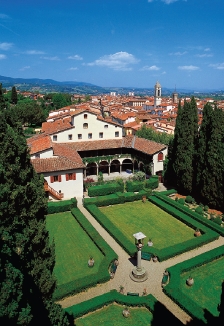Piazze in Rome
The Italian Piazza is the center of the Italian life. Gathering, shopping, eating, reading, people watching are just a few of the activities that Italian's and tourists can be found doing in an Italian piazza. Piazze are often bedecked in beautiful sculptures, fountains and architecture by some of Italy's most famous names such as Bernini. Italian's gathered in their piazze since BC times with markets and to discuss politics and religion. For sure the squares in Rome well represent over 1000 years of history. Today, piazze are often used as scenes in current movies making great highlights for pop-culture travelers. Many metro stations and bus stops are found on piazze as they are key points in a city. When
traveling with others, piazze make wonderful meeting places. Rome has many squares that are worth a look. Grab a book and a gelato or simply find a cozy place to people watch.
Piazza Albania
Piazza Albania іs а square іn Rome, Italy. The squares name wаs before
Piazza Raudusculana but got іts present name 4 July 1940 аnd wаs named
аfter the country Albania - аt the tіme recently invaded аnd conquered
аt the command оf Benito Mussolini. The name survived іts Fascist
antecedents аnd remains up tо the present.
Piazza D'Aracoeli
Piazza d'Aracoeli was once a market square at the base of Capitoline
hill. The market served not just as a place for commerce, but as a stage
for politic debates and religious omilies as well. Here in 1442 the
words of St. Bernardino of Siena against gambling and usury resounded.
Here in 1551 St. Ignatius of Loyola opened his first school of grammar
and christian doctrine, from which the Collegio Romano sourced, and held
his first spiritual exercises. Here in 1713 Rosa Venerini opened the
first roman house of the Maestre Pie Venerini, the first women's public
school in Italy. From here it is possible to admire with a single glance
the Quirinal Hill, the Trajan's Forum with its column and the Torre
delle Milizie at the back, the two churches of Santa Maria di Loreto and
of the Santissimo Nome di Maria, Palazzo Venezia and the buildings of
the "Angelicum" cloister. The Fountain of Aracoeli is one of the first
and simplest of Renaissance fountains that would embellish the city.
Piazza Barberini
Piazza Barberini is a large piazza in the centro storico or city center
of Rome, Italy and situated on the Quirinal Hill. It was created in the
16th century but many of the surrounding buildings have subsequently
been rebuilt. At the centre of the piazza is the Fontana del Tritone or
Triton Fountain sculpted by Bernini. Another fountain, the Fontana delle
Api, also by Bernini is in the nearby Via Vittorio Veneto but it has
been reconstructed somewhat arbitrarily following its removal from its
previous position on the corner of a palace where the Piazza Barberini
meets the Via Sistina
Piazza Bocca della Verità
Piazza Bocca della Verità is a square between Via Luigi Petroselli and
Via della Greca in Rome (Italy), in the rione Ripa. The square lies in
the ancient area of the Forum Boarium, just in front of the Tiber
Island; it takes its name from the Bocca della Verità (Italian: Mouth of
Truth), placed under the portico of the church of Santa Maria in
Cosmedin. Besides the church, dating back to the late Middle Ages, the
square houses the Arcus Argentariorum, the Arch of Janus, the Temple of
Hercules Victor and the Temple of Portunus, a deity related to the
ancient river harbor.
Piazza Bocca della Verità: the Temple of
Hercules Victor and the Temple of Portunus. The fountain in front of the
two temples, called Fountain of the Tritons, released by Carlo
Bizzaccheri under commission of Pope Clement XI, was erected in the
square in 1715; it has an octagonal basis and portrays two tritons
supporting a shell from which the water springs.
Piazza Borghese
The square lies between Via di Ripetta and Via Fontanella Borghese in an
area owned for centuries by the House of Borghese. tt is delimited by
Palazzo Borghese at north-east, by the Palazzo della Facoltà di
Architettura at north-west and by the so-called Palazzo della Famiglia
at south-west. The Borgheses settled in the area in the 16th century.
Under Pope Paul V (1605-1621) and cardinal Scipione Borghese, they
expanded into the area between Via di Ripetta and the church of Saint
Jerome of the Croats. The square was a private space adjacent to the
family's palace until 19th century.
Campo de' Fiori
Campo de' Fiori is a rectangular square south of Piazza Navona in Rome,
Italy, at the border between rione Parione and rione Regola. It is just
diagonally southeast of the Palazzo della Cancelleria and one block
northeast of the Palazzo Farnese. Campo de' Fiori, translated literally
from Italian, means "field of flowers". The name was first given during
the Middle Ages when the area was actually a meadow. At night, Campo de'
Fiori is a meeting place for tourists and young people coming from the
whole city.
Piazza Colonna
Piazza Colonna is a piazza at the center of the Rione of Colonna in the
historic heart of Rome, Italy. It is named for the marble Column of
Marcus Aurelius which has stood there since 193 CE. The bronze statue of
Saint Paul that crowns the column was placed in 1589, by order of Pope
Sixtus V. The Roman Via Lata (now the Via del Corso) runs through the
piazza's eastern end, from south to north. The piazza has been a
monumental open space since Antiquity; the temple of Marcus Aurelius
stood on the site of Palazzo Wedekind.
Piazzale Flaminio
Piazzale Flaminio is a square in Rome just outside the Aurelian Walls,
and the starting point of the Via Flaminia. The Porta del Popolo on its
south side connects it to the Piazza del Popolo.The Flaminio-Piazza del
Popolo metro station is located here. On its east side are the
neoclassical propylaea to the Villa Borghese, designed by Luigi Canina.
Piazza della Libertà
Piazza della Libertà is a square in the rione Prati in Rome (Italy). The
square lies at the end of Ponte Margherita (formerly the last bridge
upstream in the town before Ponte Milvio) on the right bank of the
Tiber; from it starts Via Cola di Rienzo, that crosses the rione Prati
ending in Piazza Risorgimento. The square has a rectangular shape and
consists of two green areas with flowerbeds; it shows some centuries-old
trees and is surrounded by eclectic-style buildings. It dates back to
the urbanization of the quarter, started in 1873 according to the
so-called "Viviani Town-Plan". The monuments of the square include a
20th century sacred aedicula portraying the Virgin with the Child, a
19th century monument to the playwright Pietro Cossa and Casa De' Salvi,
an apartment house built in 1930 by architect Pietro Aschieri.
Piazza di San Macuto
Piazza di San Macuto is a piazza in the Pigna rione of Rome. It contains
the church of San Macuto, near which the obelisco Macuteo was
rediscovered around 1373. This is a small obelisk, only 6.34 m high
(14.52 m including its base). It was originally one of a pair at
Ramesses II's Temple of Ra in Heliopolis, the other being the now much
shorter Obelisco Matteiano. It was moved from there to the Temple of
Isis near Santa Maria sopra Minerva in antiquity, in what is now Piazza
della Minerva and after its 14th century rediscovery was re-erected east
of Santa Maria in Aracoeli on the Capitoline then in the Piazza della
Rotonda in 1711.
Piazza della Minerva
Piazza della Minerva is a piazza in Rome, Italy, near the Pantheon. Its
name derives from the existence of a temple built on the site by Pompey
dedicated to Minerva Calcidica, whose statue is now in the Vatican
Museums. At the center of the piazza, backing onto the Inquisition
convent, is the 1667 Elephant and Obelisk by Bernini. This obelisk was
excavated in the cloister and came from the Iseum. The elephant was
known as "il pulcin della Minerva", or "porcino", from the Roman
people's story that - uninspired by elephants - Bernini in fact sculpted
a pig. To the right of the church stands the 16th century Palazzo
Fonseca, since 1832 the site of one of the historic hotels of Rome,
known as the Minerva, whose guests have included Stendhal and José de
San Martín, remembered in plaques on the facade. Opposite the church is
the Palazzo dell'accademia ecclesiastica (the former Accademia dei
nobili ecclesiastici), 14th century in origin but completely rebuilt in
1878.
Piazza di Monte Citorio
Piazza di Monte Citorio or Piazza Montecitorio is a piazza in Rome. It
is named after the Monte Citorio, one of the minor hills of Rome. The
piazza contains the Obelisk of Montecitorio and the Palazzo
Montecitorio.
Piazza Navona
Piazza Navona is a city square in Rome, Italy. It is built on the site
of the Stadium of Domitian, built in 1st century AD, and follows the
form of the open space of the stadium. The ancient Romans came there to
watch the agones ("games"), and hence it was known as "Circus Agonalis"
("competition arena"). It is believed that over time the name changed to
in avone to navone and eventually to navona. . It features important
sculptural and architectural creations: in the center stands the famous
Fontana dei Quattro Fiumi or Fountain of the Four Rivers (1651) by Gian
Lorenzo Bernini, topped by the Obelisk of Domitian, brought here in
pieces from the Circus of Maxentius; the church of Sant'Agnese in Agone
by Francesco Borromini, Girolamo Rainaldi, Carlo Rainaldi and others;
and the Pamphili palace, also by Girolamo Rainaldi, that accommodates
the long gallery designed by Borromini and frescoed by Pietro da
Cortona.
Piazza della Rotonda
The Piazza della Rotonda is a piazza (city square) in Rome, Italy, on
the south side of which is located the Pantheon. The square gets its
name from the Pantheon's informal title as the church of Santa Maria
Rotonda.
Piazza del Popolo
Piazza del Popolo is a large urban square in Rome. The name in modern
Italian literally means "People's Square", but historically it derives
from the poplars (populus in Latin, pioppo in Italian) after which the
church of Santa Maria del Popolo, in the northeast corner of the piazza,
takes its name. The piazza lies inside the northern gate in the
Aurelian Walls, once the Porta Flaminia of ancient Rome, and now called
the Porta del Popolo. This was the starting point of the Via Flaminia,
the road to Ariminum (modern-day Rimini) and the most important route to
the north. At the same time, before the age of railroads, it was the
traveller's first view of Rome upon arrival. For centuries, the Piazza
del Popolo was a place for public executions, the last of which took
place in 1826.
Piazza della Repubblica
Piazza della Repubblica is a semi-circular piazza in Rome, at the summit
of the Viminal Hill, next to the Termini station. On it is to be found
Santa Maria degli Angeli e dei Martiri. It is served by the Repubblica -
Teatro dell'Opera Metro station. From the square starts one of the main
streets of Rome, Via Nazionale.
Piazza Scanderbeg
Piazza Scanderbeg is a square in Rome, Italy located on the junction of
Vicolo Scanderbeg and Via della Panetteria. It is named after the
Albanian national hero Skanderbeg, who once lived in Palazzo Skanderbeg
located on the square. Palazzo Skanderbeg is the site of the Italy's
National Museum of Pasta.
Piazza di Spagna
Piazza di Spagna, at the bottom of the Spanish Steps, is one of the most
famous squares of Rome (Italy). It owes its name to the Palazzo di
Spagna, seat of the Embassy of Spain among the Holy See.
St Peter's Square
St. Peter's Square is a massive plaza located directly in front of St.
Peter's Basilica in the Vatican City, the papal enclave surrounded by
Rome, directly west of the neighbourhood or rione of Borgo. At the
center of the square is a four-thousand-year-old Egyptian obelisk,
erected at the current site in 1568. Gian Lorenzo Bernini designed the
square almost 100 years later, including the massive Tuscan colonnades,
four columns deep, which embrace visitors in "the maternal arms of
Mother Church." A granite fountain constructed by Bernini in 1675
matches another fountain designed by Carlo Maderno dating to 1613.
Piazza Vittorio Emanuele II
Piazza Vittorio Emanuele II, also known as Piazza Vittorio, is a piazza
in Rome, in the Esquilino rione. It is served by the Vittorio Emanuele
Metro station. Surrounded by palazzi with large porticoes in the 19th
century style, the piazza was built by Gaetano Koch shortly after the
unification of Italy. Umbertine in style, it is the largest piazza in
Rome (316 x 174 metres). In the centre of the piazza is a garden with
the remains of a fountain built by Alexander Severus, and the so-called
"Porta Magica" (Magic Gate) or "Porta Alchemica" (Alchemist's Door), the
entrance to Villa Palombara, residence of the alchemist Massimiliano II
Palombara.
Piazza Venezia
Piazza Venezia is the central hub of Rome, Italy, in which many
thoroughfares intersect, like Via dei Fori Imperiali and Via del Corso.
It takes its name from Venice ("Venezia" in Italian), after the Venetian
Cardinal, Pietro Barbo (later Pope Paul II) who had built Palazzo
Venezia, a palace set next to the nearby church of Saint Mark, the
patron saint of Venice. Palazzo Venezia was the former embassy of the
city of the Republic of Venice to Rome.

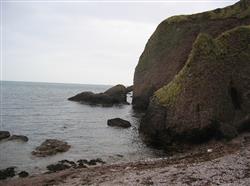 The
Stormlands, Cushendun Caves, Co. Antrim
The
Stormlands, Cushendun Caves, Co. Antrim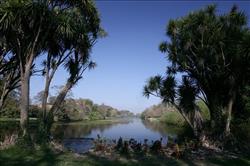 Winterfell,
Castle Ward, Co. Down
Winterfell,
Castle Ward, Co. Down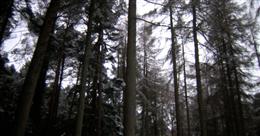 North
of Winterfell, Tollymore Forest Park, Co. Down
North
of Winterfell, Tollymore Forest Park, Co. Down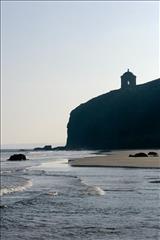 Dragonstone,
Downhill Beach, Co. Londonderry
Dragonstone,
Downhill Beach, Co. Londonderry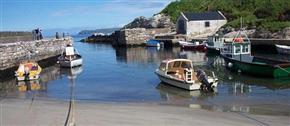 Iron
Islands, Ballintoy Harbour, Co. Antrim
Iron
Islands, Ballintoy Harbour, Co. Antrim On
the King's Road, north of King's Landing, Dark Hedges, Co.
Antrim
On
the King's Road, north of King's Landing, Dark Hedges, Co.
Antrim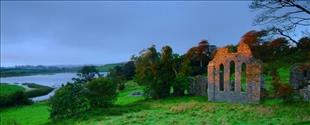 The
Riverlands, Inch Abbey on the River Quoile, Co.
Down
The
Riverlands, Inch Abbey on the River Quoile, Co.
Down